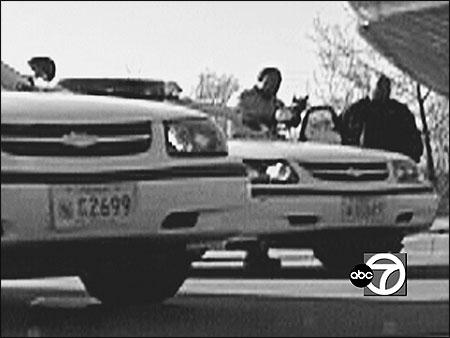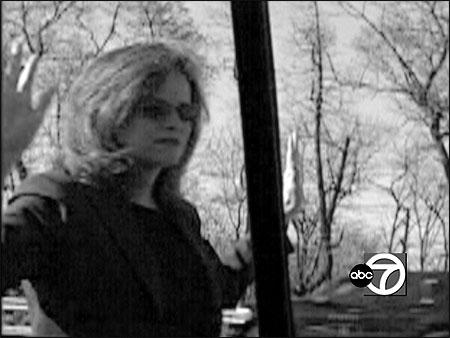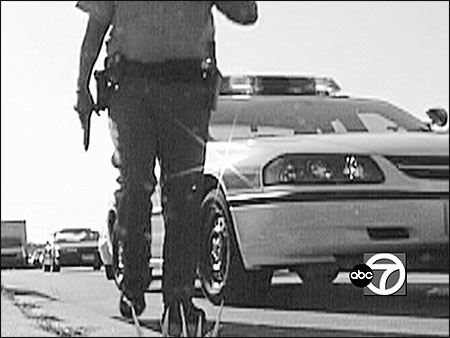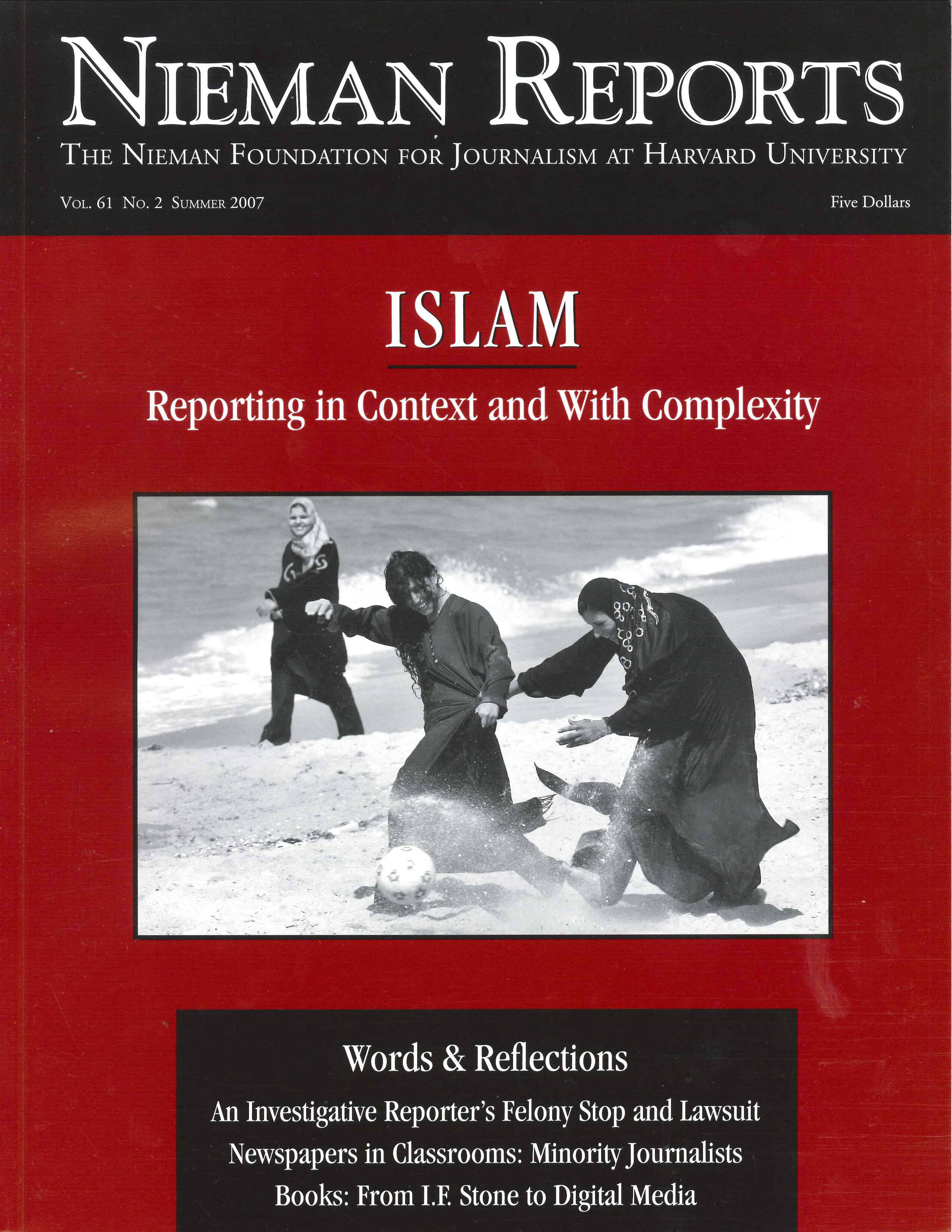I glanced in the driver’s side mirror and saw the barrel of a gun pointing at me. A young police officer held the weapon with one eye shut, the other squinting to focus on his target.
“They’ve got a gun on me,” I said to my longtime friend and photographer, Pete Hakel.
“OK, that’s fine. That’s fine,” he replied, his voice quickened by fear.
We were about to be put through a felony traffic stop, a particularly violent encounter normally reserved for fleeing murderers or suspects known to be armed and dangerous. This was not unfolding in some remote, war-torn country, but in suburban Washington, D.C. on a crisp spring morning. April 15, 2005. My life and my career would change dramatically, as would my faith in the American justice system.

Four of the dozen officers who trained their weapons on Andrea McCarren.
Pursuing a Lead
As the investigative reporter at WJLA-TV in Washington, D.C., I’d filed a series of Freedom of Information Act (FOIA) requests to follow up on numerous tips related to alleged misuse of funds in Prince George’s County, Maryland, just outside of D.C.. I cast my net around a few key players, including County Executive Jack Johnson. I wondered how, in a county with a soaring crime rate, a severely understaffed police department, widespread poverty, and an especially troubled public school system, Johnson could afford to take junkets to far-flung places, including at least two trips to Africa with large delegations of political friends and colleagues.
On April 5, 2005, I’d sent my first FOIA request to the County Office of Law in which I requested two years of travel records including all expenses for Johnson’s out-of-county travel. Between April 8th and 10th, my station and I logged frequent hostile phone calls from Johnson’s top spokesman, Jim Keary. He insisted that the information I was pursuing was “not a story” and that, if we aired it, he would never work with the station again.
When a public official vehemently argues that something is not a story, it generally is. I just needed the documentation to prove what residents had long suspected: that their government leaders were regularly misusing county funds to live lavishly, off the clock.
My investigation wasn’t the first time Prince George’s County was under close scrutiny. Its police department had such an appalling history of abusing its residents, particularly young black men, that in 2004 the United States Department of Justice (DOJ) had to take over. The police department lost several high profile lawsuits for severely beating innocent suspects and using police dogs to attack unarmed suspects. For decades, racial tension rippled from the department. Most of the officers were white; inevitably, their suspects were black.
Among the many mandates under the DOJ’s oversight was a requirement that all police cruisers be equipped with dashboard video cameras, to record all felony traffic stops.
On April 15th, despite threatening calls from the county government, Pete and I set out to investigate one of the many leads related to Johnson. A source I considered extremely reliable told me that the county’s Chief Administrative Officer, Jacqueline Brown, had a police officer acting as a personal chauffeur, picking her up at home each morning and driving her to the office and elsewhere around town. Both Brown and the officer, Corporal Danon Ashton, were considered part of Johnson’s inner circle.
The source made it clear these were not just trips to business meetings, but to dinner parties and to run errands. Other sources claimed that Ashton, who earned roughly $80,000 a year, much of it in overtime, had been seen washing Brown’s car on weekends. Many police officers resented him for making so much money in what they considered a cushy job unlike their own work on the violent streets of Prince George’s, where their lives were at risk every day.
This, I thought, would be an excellent example of two things—the county’s abuse of power and its questionable allocation of meager resources. To produce this for television, we needed to do some preliminary reporting. Early that morning, we drove to the officer’s neighborhood to learn if he had a take-home government car and whether he picked up Brown at her home. No comparable executive in any neighboring jurisdiction, including Washington, D.C., has a taxpayer-funded car and driver from the police force.
We anticipated it might take several days of surveillance just to spot his car. But to our surprise, that morning we watched from around the corner as he left his house wearing a jacket and tie, not a uniform, and got into the government-issued sports utility vehicle. We followed him from a substantial distance so as not to be detected—generally several car lengths. We were in my car with Maryland tags, since our news vehicles are either marked with the station logo or are distinctive dark blue Crown Victorias. (It was not unusual for me to take my personal car on investigative assignments.)
I drove. Pete sat in the middle of the back seat so he could keep his large video camera on his shoulder without being blocked by the car’s headrests. We followed Ashton for more than 20 miles and watched as he drove down a private driveway with an ominous-looking, hand-painted sign that read in big letters, “No Trespassing.” We weren’t about to break the law. In fact, as we followed Ashton on many public roads, we made a special effort to remain within the speed limit (even when he didn’t), and I was also careful to use turn signals every time I changed lanes or turned onto another street. We wanted the story, but we wanted to be cautious about getting it in a proper, legal way.
We pulled to the side of the road and waited for several minutes. When he didn’t surface, we decided to move on to investigate another lead, also in Prince George’s County.
As we studied our map, I was startled to see in my rearview mirror Ashton’s vehicle pull in behind us. He had a passenger in the car, one who appeared to be Brown. I held my breath and anticipated Ashton coming to my window to ask who we were and what we were doing. But seconds later, he was slowly driving around our car, and soon took a right and joined the flow of traffic. Our eyes never met. But we were sure he was calling in my license plate number. The car was registered in my name. The game was over, or so we thought.

Both sides of the highway were quickly shut down by the officers.
The Police Descend—With Guns Drawn
We had to drive in the same direction, so again we followed Ashton and his passenger and observed them from a distance, driving past two police substations. Both appeared to be on their cell phones for much of the drive. As we passed the county police headquarters, Ashton braked. Again, we thought we’d been discovered and that Ashton would drive into the main parking lot, and we’d have some explaining to do. But he drove on, and we followed, staying several car lengths away.
About a minute later, the pulsating scream of sirens and the sight of flashing blue lights surrounded us. Three police cruisers sped past us.
“Something’s happening,” I mumbled to Pete.
“Yup, breaking news,” he responded.
Suddenly, the three cruisers abruptly stopped. Two additional cars pulled to the left side of my car, forcing me to pull over. Two more screeched to a stop behind me. Two others stopped on the other side of the median on this divided highway. Officers immediately shut down all traffic in both directions, in a heavy morning rush hour.
Sources in the police department would later tell me that the call went out as “an officer in trouble,” the highest possible distress call. They also said that there was no description of the suspects, which many found unusual. Apparently, dispatch only issued a description of my car, a black Toyota Highlander. In fact, sources said the first three police cruisers had screamed past us because they had “assumed the suspects would be young black men” and that I “didn’t fit the profile.” Other officers had apparently alerted them to the fact that this woman in business attire was indeed their “suspicious person.”
At our station’s assignment desk, the police scanners buzzed with activity. Two assignment editors heard police chatter about pulling over “suspects with a video camera.”
My heart was pounding when I saw the image in my side mirror.
“Ma’am, turn off the ignition, roll down your window, and with your right hand only, drop your keys to the ground,” shouted a man I couldn’t see. I complied.
“Ma’am, with your right hand only, open your door, and keep your hands where we can see them,” said this disembodied voice.
Again, I did as I was told. But as I stepped out in my business suit and heels, instinct told me to take a look at what I was up against. Nearly as soon as I turned, the voice yelled, “Face the front. Put your hands up and back up to the sound of my voice.” Yet in those few seconds, I’d glimpsed a terrifying scene: what appeared to be about a dozen officers, all armed, most pointing their gun at me. Some crouched down behind the safety of their open cruiser doors. Others leaned on their vehicles to steady their aim.

McCarren complies with police orders.
There must be some mistake, I thought. I shuffled backwards, my arms toward the sky. I had no idea at the time that Pete, a 60-year-old veteran photographer, had been quietly rolling videotape from the back seat of the car since the flashing lights and sirens first surrounded us.
Please don’t shoot me. Please don’t shoot Pete. Those words reverberated again and again in my head, but as I walked backwards, I anticipated the crackle of a gunshot. Would the bullet pierce my lower back, I wondered? Or would I simply be shot in the head?
While my mind briefly wandered, I was startled by the grasp of a thick hand, cuffing my right wrist and snapping it behind my back. The pain was immediate. My right shoulder felt like it was on fire. I don’t remember how my left arm was brought down, but I recall my wrists being in the firm grasp of a man whose face I couldn’t see. With my wrists bound, my elbows nearly together in an awkward and excruciating position, my arms were abruptly yanked skyward behind my back as I was pushed over the hood of a police cruiser.
“Do you have a weapon?” asked a voice from behind me.
“No,” I replied, stunned by the question.
My response didn’t matter. I was roughly frisked with the inside of the officer’s hand, under my blazer, in between my legs.
“I’m a reporter.” I remember being surprised at how meekly the words came out. “My press credentials are in the front of my car.”
The exchange was interrupted by a new frenzy of activity. The officers had discovered Pete in the back seat. I looked up to see armed officers hustling toward my car.

McCarren’s photographer rolled on the incident until police seized his camera.
“Drop the camera!” screamed an officer.
Pete had exited the car with his only weapon, a video camera, and it was rolling. At gunpoint, he placed it on the ground in the direction of the armed officers, who were about to frisk him. His actions at this moment struck me as one of the bravest acts I’ve ever witnessed. He would later say he rolled the tape “to show at our memorial service.”
One of the officers who gently placed Pete’s hands behind his head saw that there was a camera pointing at him. He signaled another officer to remove it. The officer did, tossing it into the back seat of my car, still rolling. For the next several minutes, audio was captured of the conversation between the officers, most of whom felt confused and angry by their order to chase down what turned out to be a television news-crew pursuing a story.
Pete was quickly released after they’d frisked him. I was still detained. An officer took my purse from inside my car and dumped the contents on the hood. I was embarrassed but, at that moment, it felt like the least of my worries. Among my possessions were several press passes, allowing me access to the White House, the Pentagon, and the Capitol. The officers sifted through the stack of credentials, and the one holding my wrists together released his grip. I was relieved but filled with adrenaline and extreme pain in my right shoulder, as I heard a new round of scanner traffic come across what sounded like a loudspeaker.
“The car is registered to an Andrea McCarren. Of Bethesda,” said a woman’s voice.
The officers instructed me to put my belongings back in my purse, and one held my arm and walked me to the side of the road. I was ordered to “wait right there.” A different officer stood shoulder-to-shoulder with me and shouted in my ear, “What are you doing here?”
Still nervous, I simply replied, “I’m a reporter.”
“I didn’t ask what you were,” he screamed. “I asked what you were doing.”
“I’m a reporter on a story. I’m following up on some leads,” I stammered.
Just then, a group of officers walked up with Pete, and we numbly looked at each other.
They told us to leave, that they needed to get traffic moving again.
But before we left, we had some questions to ask them. Why were we stopped? What laws had we broken? We asked for a public information officer to come to the scene, as is required at any incident involving a member of the media. It was now about 9 a.m., but we were told no one was available. We were never formally arrested, never charged with a crime.
Pete instinctively started to roll his camera as I spoke with the lead officer, who put his hand in front of the camera and said, “I’m not doing an interview.”
We left the scene. I was too rattled and in too much pain to drive, so Pete did. Before we drove away, Pete remembers seeing Ashton and Brown in their car on the other side of the median—watching and, he believed, smiling.
The Aftermath
The months that followed were indescribably painful, physically and emotionally. One colleague phoned me the next day to say I’d “fucked up” his sources in the police department. Another said he wished it had happened to him, because he thought the attention might advance his career. Some officers called my colleagues to offer their criticism. They said Pete was “stupid” to come out of the car with the camera and “deserved to get shot.”
Although I was the first journalist in the United States known to be subjected to a felony traffic stop while on the job, some officers said I was “lucky it wasn’t a real one.” Had it been, they claimed, I would have been “eating the pavement.” One police official told Washingtonian magazine, “McCarren should quit her whining. She wasn’t shot.”
In the months that followed, I suffered frequent nightmares and flashbacks. In the rare hours that I slept, I’d wake up crying. My right shoulder throbbed at night, wrapped in an ice pack. After months of tears and isolation, I was diagnosed as a “classic case of post-traumatic stress disorder” and began treatment, which ultimately may have saved my life.
An orthopedic surgeon diagnosed my shoulder injury as a subluxation or dislocation. I wore a sling for more than a month, took strong painkillers, and did months of physical therapy, with little success.
I never missed a day at work, feeling under pressure to continue the investigation. The story aired less than a month after our traffic stop. Today, nearly two years after the incident, I am preparing for surgery to repair torn tendons in my shoulder.
The local media, especially WTOP, Washington’s all-news radio station, kept up the pressure on the county government to provide answers to the media and its residents.
Nine police cruisers were on the scene and, despite the DOJ mandate to have working dashboard video cameras running for felony stops, not one of them had recorded the stop.
The police department contradicted itself publicly, saying either the tapes were “missing” or that the cameras weren’t rolling and that some of the cruisers were not equipped. Although Pete remarkably captured much of the incident on tape, I walked out of frame before I was injured.

Dashboard camera videotapes from the nine cruisers are still missing.
The county never complied with our repeated requests for 911 tapes and cell phone records of all the law enforcement personnel involved, plus the cell phone records from Brown, Ashton, Johnson and Keary. Police sources told us that officers and other security personnel don’t use 911 in an emergency, but a special number that is not recorded and goes directly to the communications supervisor, instead of dispatch. That might explain why there are apparently no 911 tapes.
When the FOIA requests went unfulfilled past the 30-day legal requirement, and after several follow-up calls, the station decided to go public. Our primary news anchor, the well-respected veteran journalist Gordon Peterson, reported the story. It appeared the same day on the front page of The Washington Post’s Metro section, along with still pictures taken from Pete’s video of me with my hands up, surrounded by officers pointing their guns at me. When pressed for a public explanation of their violent stop of a 5’4″, 115-pound mother of three, county spokesman Keary said I could have been “a terrorist,” and likened me to the pilot who flew his Cessna into restricted air space near the White House. The county’s mantra became, “Terrorists come in all shapes and sizes.”
Prince George’s County Executive Jack Johnson went on television and radio saying he believed his officers “acted appropriately” and that “the use of force was reasonable.” Police Chief Melvin High repeatedly promised WTOP Radio that he would “get to the bottom of this,” and “if our people didn’t do what they were supposed to do … they’re held accountable.” The county’s Public Safety Director Vernon Herron told The Washington Post that government officials are “threatened and assaulted every day, some even killed in the performance of their duties.” When the Post reporter asked if Brown has ever been threatened, Herron said no.
Johnson and High both promised a “thorough investigation.” In Prince George’s County, internal police investigations go before a citizen’s advisory panel, which makes a recommendation to the county. Although it was small vindication, the panel recommended that two officers be disciplined for not having their cruiser cameras running. We were never permitted to learn the nature of their punishment.
After the Post article and a follow-up appeared in print, my three children faced unnerving questions at their elementary school about why their mother “was arrested.” Police cars drove slowly by our house and even parked in front in a not-so-veiled threat. Law enforcement, I have learned, has tremendous leeway in this post 9/11 world, to do whatever it deems necessary to a citizen—journalist or not—with little risk of repercussions.
I was raised as the daughter of a civil rights lawyer who did much of his work pro bono. I truly believed that justice would be served. I was wrong. In the year that followed the April 2005 incident, I consulted numerous high-profile lawyers, one of whom took the case on contingency only to realize later that as difficult as the case was, he needed to get paid. He estimated our costs to be around $150,000. I found a second legal team that I trusted who agreed to take the case on contingency. We prepared a lawsuit and, just as we were about to file, the county asked us to try mediation. One of the lawyers had a particularly good relationship with the county attorney’s office and convinced me this was the way to go.
On October 3, 2006, county representatives and one of my lawyers and I went into five uncomfortable hours of mediation. My trust was in my legal team and the highly respected retired federal judge who served as our mediator. The proceedings were confidential, although I can’t erase the comment made by one county lawyer who said before we began, “Let’s not make more of this than it was.” Eventually, we hammered out a financial agreement, which left both sides feeling vaguely satisfied. More difficult to agree on was my insistence on a written public apology from the county to my family and me.
I’d been publicly dragged through the mud, my reporting methods assailed, and yet I hadn’t broken a law and hadn’t been charged with a crime. Somehow, the mediator delicately led us to a joint statement with carefully chosen words. I left feeling somewhat vindicated for the first time in more than a year. Both sides signed the agreement. The letter of apology and the check to cover my medical expenses were to be in my hands by mid-November 2006.
Today, nearly two years after the incident and six months after mediation, the RELATED WEB LINK
Watch ABC-7’s coverage of the incident »
– youtube.comcounty has not followed through on its legal commitment. Despite the efforts of my lawyers, the county has passed deadline after deadline, reneged on promise after promise. I can’t help but think that if someone like me, with a relatively high-profile job and the resources of a two-career family cannot see justice, who can?
Andrea McCarren, a 2007 Nieman Fellow, is the investigative reporter for WJLA-TV in Washington, D.C.. The Associated Press recognized her stories on corruption in Prince George’s County with its top regional award for investigative reporting. In April 2007, McCarren filed a lawsuit against Prince George’s County for violating her constitutional rights. A story about this incident can be found on YouTube.com. [See related Web link above.] McCarren will teach two journalism classes at the Harvard Summer School, including the first broadcast journalism course in Harvard history.


